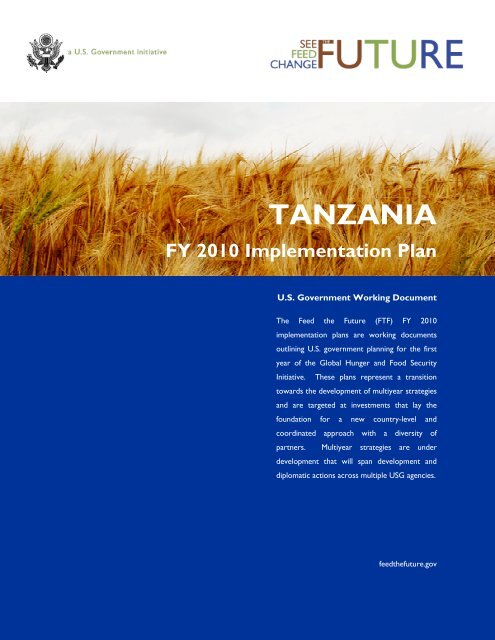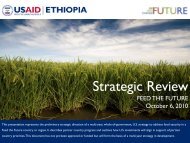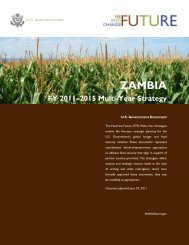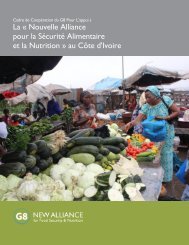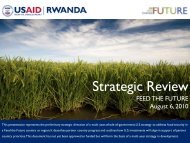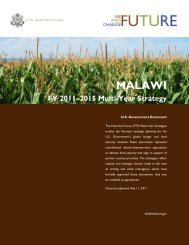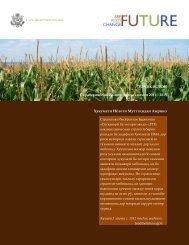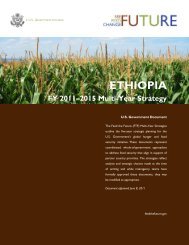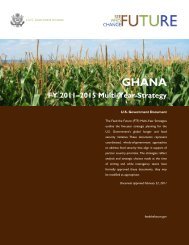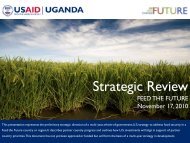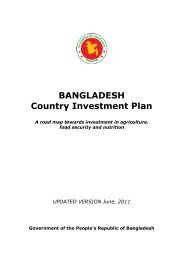Feed the Future FY 2010 Implementation Plan, Tanzania
Feed the Future FY 2010 Implementation Plan, Tanzania
Feed the Future FY 2010 Implementation Plan, Tanzania
- No tags were found...
You also want an ePaper? Increase the reach of your titles
YUMPU automatically turns print PDFs into web optimized ePapers that Google loves.
TANZANIA<strong>FY</strong> <strong>2010</strong> <strong>Implementation</strong> <strong>Plan</strong>U.S. Government Working DocumentThe <strong>Feed</strong> <strong>the</strong> <strong>Future</strong> (FTF) <strong>FY</strong> <strong>2010</strong>implementation plans are working documentsoutlining U.S. government planning for <strong>the</strong> firstyear of <strong>the</strong> Global Hunger and Food SecurityInitiative. These plans represent a transitiontowards <strong>the</strong> development of multiyear strategiesand are targeted at investments that lay <strong>the</strong>foundation for a new country-level andcoordinated approach with a diversity ofpartners. Multiyear strategies are underdevelopment that will span development anddiplomatic actions across multiple USG agencies.feed<strong>the</strong>future.gov
Table of Contents1. INTRODUCTION...................................................................................................................................52. <strong>FY</strong> <strong>2010</strong> OBJECTIVES .............................................................................................................................53. TARGET GROUPS BY LOCATION AND INCOME.....................................................................94. CORE INVESTMENT AREAS............................................................................................................. 105. <strong>FY</strong> <strong>2010</strong> RESULTS/ INDICATORS/ TARGETS .............................................................................. 216. KEY ISSUES AND ANALYTICAL ACTIVITIES LOOKING TOWARD <strong>FY</strong>2011................... 247. PARTNERSHIP PLAN .......................................................................................................................... 248. <strong>FY</strong> <strong>2010</strong> CAPACITY BUILDING PLAN........................................................................................... 269. MANAGEMENT PLAN........................................................................................................................ 282
Abbreviations and AcronymsAGRAAgCLIRAOTRASARECAASDPBESTBizCLIRCAADPCGIARCFPCOMPETECOTRCRSPDAIDCADFIDDPGEACEGATFANTAFAOFCIFDIFEWSNET<strong>FY</strong>GATEGBSGDAGDPGFSRGOTHEPADHBSIITAIFADIQCiWASHJASTLGUMDGsMEMSMKUKUTAMTMUSNAPANBSNEPADNOAAAlliance for Green Revolution in AfricaAgribusiness Climate Legal Institution ReformAgreement Officer Technical RepresentativeAssociation for Agricultural Research in East and Central AfricaAgriculture Sector Development ProgramBusiness Environment Streng<strong>the</strong>ning of <strong>Tanzania</strong>Business Climate Legal Institutional ReformComprehensive Africa Agriculture Development ProgramConsultative Group of International Agriculture ResearchCochrane Fellowship ProgramCompetitiveness and Trade ExpansionContracting Officer Technical RepresentativeCollaborative Research Support ProgramDevelopment Alternatives IncorporatedDevelopment Credit AuthorityDepartment for International DevelopmentDevelopment Partners GroupEastern Africa CommunityEconomic Growth, Agriculture and TradeFood and Nutrition Technical AssistanceFood and Agriculture OrganizationFinancial Crisis InitiativeForeign Direct InvestmentFamine Early Warning System NetworkFiscal YearGreater Access to Trade ExpansionGeneral Budget SupportGlobal Development AllianceGross Domestic ProductGlobal Food Security ResponseGovernment of <strong>Tanzania</strong>Higher Education Partnerships for African DevelopmentHousehold Budget SurveyInternational Institute of Tropical AgricultureInternational Fund for Agriculture DevelopmentIndefinite Quantity ContractIntegrated Water, Sanitation and Hygiene programJoint Assistance Strategy for <strong>Tanzania</strong>Land Grant UniversityMillennium Development GoalsMonitoring and Evaluation Management SystemNational Strategy for Growth and Poverty Reduction (GOT)Metric TonsMultiple Use ServicesNational Adaptation <strong>Plan</strong> for ActionNational Bureau of StatisticsNew Partnership for Africa’s DevelopmentNational Oceanic and Atmospheric Administration3
NAROTAPAPAPLACEPESARANETSADCT-MEMSTAHATASTATFNCTMATPSFTTISUSACEUSAIDUSGUSDAUSTDAWFPWIDWLTIEWTONational Agricultural ResearchOffice of Technical AssistanceParticipating Agency Program AgreementProsperity, Livelihoods and Conservation EcosystemsPrivate Enterprise Support ActivitiesRadio and Internet for <strong>the</strong> Communication of Hydro-Meteorological and ClimateRelated InformationSou<strong>the</strong>rn Africa Development Community<strong>Tanzania</strong> Monitoring and Evaluation Management Services<strong>Tanzania</strong> Horticultural Association<strong>Tanzania</strong> Seed Trade Association<strong>Tanzania</strong> Food and Nutrition Center<strong>Tanzania</strong> Meteorological Agency<strong>Tanzania</strong> Private Sector Foundation<strong>Tanzania</strong> Trade Integration StrategyUnited States Army Corps of EngineeringUnited States Agency for International DevelopmentUnited States GovernmentUnited States Department of AgricultureUnited States Trade and Development AgencyWorld Food ProgramWomen in DevelopmentWomen’s Leadership Training in EconomicsWorld Trade Organization4
1. INTRODUCTIONUSG assistance to <strong>Tanzania</strong>’s agriculture andfood security effort could not come at a morecritical time. MKUKUTA, <strong>the</strong> National Strategyfor Growth and Poverty Reduction, is not ontrack to meet <strong>the</strong> Millennium DevelopmentGoals (MDGs) for reducing <strong>the</strong> percentage ofpeople below <strong>the</strong> food poverty line and halving<strong>the</strong> number of people below <strong>the</strong> incomepoverty line. The 2007 Household BudgetSurvey (HBS) established that <strong>the</strong> number ofpeople living below <strong>the</strong> poverty line increasedby one million between 2001 and 2007.<strong>Tanzania</strong> performs moderately better in foodself-sufficiency compared with o<strong>the</strong>r countriesin <strong>the</strong> region, but malnutrition is rampantamong under-five children (38% stunted and22% underweight), and <strong>the</strong> country remainsvulnerable to food price fluctuations.Conditions are ideal for <strong>Tanzania</strong> to benefitfrom significant increases in agriculturalassistance to support scaled impact in foodsecurity. Food security is paramount in<strong>Tanzania</strong>’s development agenda, and <strong>the</strong> 2006-2015 Agricultural Sector Development Program(ASDP) identifies implementation andmonitoring plans to link results to investments.There is agreement that a ComprehensiveAfrica Agriculture Development Program(CAADP) compact and a joint monitoring planlinking <strong>the</strong> USG food security initiative to ASDPwill be established by end of <strong>the</strong> <strong>2010</strong> programyear.In <strong>FY</strong> <strong>2010</strong>, <strong>the</strong> Global Hunger and FoodSecurity Initiative (GHFSI) will lay <strong>the</strong>groundwork for future investments. By utilizingcurrent implementing mechanisms andleveraging existing national strategies andprocesses to conduct requisite analyticalassessments, program design, training andcapacity building, <strong>the</strong> GHFSI will produce rapidresults.Internally, USAID/<strong>Tanzania</strong> (<strong>the</strong> Mission) has adynamic, focused staffing plan to accommodateanticipated increased resources andresponsibilities, and <strong>the</strong> full support of <strong>the</strong> USGin-country to design and roll out this majorinitiative.2. <strong>FY</strong> <strong>2010</strong> OBJECTIVESThis report outlines <strong>the</strong> USG/USAIDimplementation plan for <strong>the</strong> emerging foodsecurity framework in <strong>Tanzania</strong>, <strong>the</strong> goal ofwhich is to “Increase Agricultural Growth andExpand <strong>the</strong> Staple Food Supply.”2.1. COUNTRY-LEDCOMPREHENSIVE STRATEGYThis program aligns with and will contribute to<strong>the</strong> 2006-2015 Agricultural SectorDevelopment Program (ASDP), <strong>Tanzania</strong>’sroadmap for agricultural development thatforms part of <strong>the</strong> broader National Strategy forGrowth and Poverty Reduction (MKUKUTA).These coordinated initiatives, coupled withrenewed efforts by GOT to invigorateagriculture through <strong>the</strong> Kilimo Kwanza(Agriculture First) campaign, and a recently fasttrackedCAADP Compact process, mark a newstage in <strong>the</strong> transformation of <strong>Tanzania</strong>’s laggingagriculture sector. These combined efforts willaccelerate progress toward achievement ofMDG 1: To halve <strong>the</strong> proportion of peopleliving below <strong>the</strong> poverty line and suffering fromhunger by 2015.2.1.1. Consultative ProcessThe Mission has played <strong>the</strong> lead role in USGsupport to <strong>the</strong> agriculture sector, workingclosely with o<strong>the</strong>r USG organizations through a‘whole-of-government’ approach. USAID has<strong>the</strong> technical expertise and capacity to lead thisinitiative, and <strong>the</strong> contributions and priorities ofo<strong>the</strong>r USG actors are fully integratedthroughout <strong>the</strong> plan. The results of our work insupport of <strong>Tanzania</strong>’s agriculture sector—inpartnership with GOT and o<strong>the</strong>r donors—areextraordinary, considering extremely low USGfunding levels of $2-3 million annually overrecent years. Most development assistance in<strong>Tanzania</strong> is in <strong>the</strong> form of General Budget5
Table 1: Accelerated CAADP Timeline for <strong>Tanzania</strong>Month March <strong>2010</strong> April <strong>2010</strong> May <strong>2010</strong> June <strong>2010</strong>Activities 1 2 3 4 1 2 3 4 1 2 3 4 1 2 3 4Preparatory work for <strong>the</strong>Scoping MissionScoping Mission to reviewASDP and completeanalytical workFinalization of ScopingMission reportsStock taking and preparationof a draft CompactFinalization of draft Compact/ Consultative processCompact signing2.2. AFRICAN CAPACITYBUILDING<strong>FY</strong> <strong>2010</strong> funds will support streng<strong>the</strong>ning <strong>the</strong>capacity of food security implementing partners.Over 100 partners will be trained on foodsecurity and nutrition, policy issues, strategicplanning, monitoring and evaluation,entrepreneurship and agribusiness development,value chain optimization, climate changeadaptation, river basin management, safety netsand outreach to vulnerable smallholderpopulations.2.3. INVEST IN PRIORITYACTIONS<strong>Tanzania</strong>’s comprehensive approach willadvance <strong>the</strong> following key GHFSI objectives.(including <strong>the</strong> first pilot MicroCLIR instaples), policy-enabling environment(AgCLIR), gender constraints andparticipation, CAADP – ASDPharmonization, irrigation potentia,; trainingand capacity-building needs, and nutrition(building on WFP’s pending national foodand nutrition vulnerability assessment);Taking a lead donor role partnering withGOT to support <strong>the</strong> CAADP Roundtableand Compact;Leveraging prior investments in agricultureand linkages to o<strong>the</strong>r USG developmentprograms in <strong>Tanzania</strong>;Formalizing USG and donor coordinationmechanisms; andIncrease sustainable market-led growthacross <strong>the</strong> entire food production andmarket value chains;Prevent and treat undernutrition; andBuilding joint monitoring programs betweenGHFSI and <strong>the</strong> GOT ASDP, and finalizingPerformance Monitoring <strong>Plan</strong>s for <strong>the</strong> <strong>FY</strong><strong>2010</strong> bridge-year and comprehensive rolloutof GHFSI in <strong>FY</strong> 2011.Increase <strong>the</strong> impact of humanitarian foodassistance and social safety nets.To achieve this ambitious outcome, <strong>FY</strong> <strong>2010</strong>actions will lay a sound, multi-year foundationfor GHFSI by:Filling critical analytical gaps throughtargeted assessments in value chains8
3. TARGET GROUPS BYLOCATION ANDINCOME<strong>Tanzania</strong> has made some progress towardsMillennium Development Goal 1: To halve <strong>the</strong>proportion of people living below <strong>the</strong> povertyline by 2015. However, based on 1990-2007trends, <strong>Tanzania</strong> will miss <strong>the</strong> MDG1 goalwithout interventions to accelerate povertyreduction.<strong>Tanzania</strong> experiences high regional and seasonalvariability in poverty levels and food availability.Agriculture in <strong>Tanzania</strong> employs 80% of <strong>the</strong>workforce and contributes one-third of GDP.Poverty is highest in <strong>the</strong> Central Zone regionsof Dodoma, Manyara and Singida, and along <strong>the</strong>sou<strong>the</strong>rn coast. Fifteen districts are generallyclassed as chronically food deficient, primarily in<strong>the</strong> central regions of Dodoma, Manyara,Singida and Tabora.Undernutrition is most prevalent in youngchildren (under-five) from <strong>the</strong> poorest and ruralhouseholds, while Vitamin A and micronutrientdeficiency is most common among children, andpregnant and lactating mo<strong>the</strong>rs. A recent ChildPoverty Report (REPOA, NBS and UNICEF,2008,) highlights disparities in nutrition, withstunting rising 8% among <strong>the</strong> pooresthouseholds (mostly in Central Zone andsou<strong>the</strong>rn coast) at <strong>the</strong> same time that <strong>the</strong> leastpoorhouseholds experienced a 20% drop(1999-2004.)Prioritizing agricultural households in GHFSItarget regions will maximize <strong>the</strong> impact of USGinvestments to accelerate <strong>Tanzania</strong>’s progress inachieving MDG 1.GHFSI target regions have an estimatedpopulation of 6 million (indirect beneficiaries)and nearly 1 million farming households (directbeneficiaries.) The 2007 Household BudgetSurvey (HBS) indicates that well over one-thirdof people in GHFSI target rural areas live below<strong>the</strong> poverty line (37.6%), much higher than inDar es Salaam (16.4%) or in o<strong>the</strong>r urban areas(24.1%). Poverty is particularly acute in Zanzibarwhere nearly half (49%) of approximately onemillion people live below <strong>the</strong> income povertyline.GHFSI target regions in central and nor<strong>the</strong>rn<strong>Tanzania</strong> are areas with high agriculturalpotential that serve as gateways to chronicallyfood-insecure districts. Morogoro and Zanzibarwill be <strong>the</strong> focus of irrigated rice production,while maize value chains will be promoted inDodoma and Manyara regions. Both Dodomaand Manyara suffer from chronic food shortagesdespite strong potential for agriculturaldevelopment.Table 2: <strong>Tanzania</strong>’s roadmap to MDG1: To halve by 2015, <strong>the</strong> proportion of people living belowpoverty line and suffering from hungerIndicator1990(Baseline)2000Results2007Results2015(Target)Percentage of people living below income poverty line 39 36 33.6 19.5Percentage of people living below food poverty line 22 19 16.6 11Percentage of under-weight under-5 children 28.8 29.5 22 14.4Percentage of under-height under -5 children (stunted) 46.6 44.0 38 23.3Source: Poverty and Human Development Report – 2007, United Republic of <strong>Tanzania</strong>, Ministry of Finance andEconomic <strong>Plan</strong>ning.9
Figure 2: Accelerating <strong>Tanzania</strong>’s Progress towards MDG1Percent504540353025201510501990 2000 2007 2015Year% below income povertyline% below income food line% under-5 childrenunderw eight% under-5 childrenstunted4. CORE INVESTMENTAREASThe Mission’sagriculture andfood securityinvestment areashave beenestablished througha collaborative,analytical process,including review ofASDP, intensiveconsultations withall relevant GOTministries and keydonor partners, andcompletion of twoMorogoro is one ofsix regions earmarkedby GOT as a priorityfor national foodsecurity and <strong>the</strong> targetarea is a frontier to<strong>the</strong> semi-arid CentralZone with chronicfood insecurity and<strong>the</strong> highest levels ofpoverty andmalnutrition in <strong>the</strong>country.analytical assessments over <strong>the</strong> past fourmonths (<strong>the</strong> “Agriculture Value ChainSyn<strong>the</strong>sis” and <strong>the</strong> “Agriculture EnablingEnvironment BizCLIR Pre-Analysis”). Thisprocess resulted in a food security programdesigned to increase food production andavailability (staples) and streng<strong>the</strong>n secondaryvalue chains (horticulture and livestock) inorder to improve household incomediversification and nutrition, particularly forwomen and smallholder farmers.4.1. CORE AREAS<strong>Tanzania</strong>’s comprehensive GHFSI approach wasdeveloped through intensive consultations andwill enhance productivity, private sectoractivities, <strong>the</strong> enabling environment forinvestment and trade, and adaptation to climatechange. At <strong>the</strong> same time, it will address <strong>the</strong>needs of vulnerable populations, particularlywomen and children. Proposed activities are inline with <strong>the</strong> 2005 <strong>Tanzania</strong> medium-termCAADP investment plan.In order to intensify impact, USAID assistancewill focus primary investments on <strong>the</strong> centraland nor<strong>the</strong>rn regions of Morogoro, Dodomaand Manyara. The geographic focus takes intoconsideration agriculture potential, activities ofo<strong>the</strong>r donors, previous USG, o<strong>the</strong>r donor andGOT investments, and potential for regionaltrade along transport corridors. Morogoro isone of six regions earmarked by <strong>the</strong> GOT as apriority for national food security. The targetarea is a frontier to <strong>the</strong> semi-arid Central Zonewith chronic food insecurity and <strong>the</strong> highestlevels of poverty and malnutrition in <strong>the</strong>country.Annual staples demand in <strong>Tanzania</strong> is about 10million tons with maize (3.66 million) and rice10
(1.34 million)accounting for half of<strong>the</strong> total. <strong>FY</strong> <strong>2010</strong>investments will set<strong>the</strong> stage for a fiveyearplan to increasestaples supply in<strong>Tanzania</strong> by 25%(1.25 million tons),turning <strong>Tanzania</strong> intoa net exporter by2014.USAID assistance is based on six establishedcriteria:Potential to impact food security at <strong>the</strong>household level;Impact on poverty reduction;Potential for regional trade;<strong>FY</strong> <strong>2010</strong>investments will set<strong>the</strong> stage for a fiveyear plan toincrease staplessupply in <strong>Tanzania</strong>by 25% (1.25 milliontons), turning<strong>Tanzania</strong> into a netexporter by 2014.Overall economic impact and cross-sectorallinkages;Potential to reduce risk and vulnerability toclimate change; andPotential to improve <strong>the</strong> enablingenvironment and private sectorcompetitiveness.In addition to staples, USAID will continue tosupport and expand horticulture and livestockas secondary value chains.Deficiencies in energy and protein, andmicronutrients such as minerals and vitamins,are high in <strong>Tanzania</strong>. Horticulture contributesto food security through increased income(improving household purchasing power) andopportunities for nutritional diversification.Horticultural crops are popular with womenfarmers and not land intensive. Given that landin <strong>Tanzania</strong> is commonly inherited alongpaternity lines, horticulture is less prone to landtenure constraints.USAID livestock support offers an opportunityto reach vulnerable populations in pastoralcommunities who depend on markets for <strong>the</strong>irfood grain supply. <strong>Tanzania</strong> has <strong>the</strong> third largestlivestock population in Africa (over 15 millionhead), but <strong>the</strong> sector contributes only 6.1% ofGDP. A recent study estimated that over280,000 head of cattle are exported informallyto Kenya alone. Development of a profitableand formalized livestock value chain willincrease livestock keepers’ incomes, choice indomestic markets and overall export revenue.4.1.1. Increased AgriculturalProductivity – Irrigation, RuralRoads, Farm InputsCurrent/Potential USG/Donor Partners:USDA, ASDP Basket (World Bank, Japan,Ireland, IFAD, AfDB), <strong>the</strong> Gates FoundationMDG1: Increasing productivity will reduce <strong>the</strong>number of people suffering from hungerKey Issue: Low productivity has hampered<strong>Tanzania</strong>’s growth in <strong>the</strong> agricultural sector.Most staples have yields of less than one ton/ha.The 2002-2003 agricultural census shows that<strong>Tanzania</strong>’s average yields for maize and rice arefar below <strong>the</strong> African average at 0.75 (1.29tons/ha in Africa) for maize, and 0.95 (2.3tons/ha in Africa) for rice. Low productivity ofcereals in <strong>Tanzania</strong> is attributed to dependencyon rain-fed agriculture and low usage offertilizer, improved seeds and pesticides.GOT Priority:<strong>Tanzania</strong> has over2.3 million ha of highpotentialland forirrigation, but only289,245 ha aredeveloped. The ASDP<strong>Tanzania</strong> has over2.3 million ha ofhigh potential landfor irrigation butonly 289,245 ha aredeveloped.target to develop 441,000 ha of land forirrigation by <strong>2010</strong> is far from being reached.Morogoro Region is considered to have <strong>the</strong>highest irrigation potential, but remains <strong>the</strong>least developed in irrigation infrastructure withover 350,000 agricultural families usingtraditional irrigation canals in Morogoro. TheMinistry of Agriculture has completed feasibilitystudies for seven irrigation schemes identified in<strong>the</strong> National Irrigation Master <strong>Plan</strong>.ASDP has allocated resources to support avoucher system for fertilizer and seed subsidies.11
In <strong>FY</strong> 2008, <strong>the</strong> GOT spent $53 million on aninput subsidy voucher system in partnershipwith <strong>the</strong> Alliance for Green Revolution (AGRA)supporting value chain development for inputs,including agro-dealer training on business skills.In June 2009, <strong>the</strong> World Bank approved anadditional $220 million for ASDP to addressfood security through <strong>the</strong> Accelerated FoodSecurity Program. Of <strong>the</strong> total fund,$160 million is allocated for expansion of <strong>the</strong>voucher system for farm inputs.To capitalize on this investment, <strong>the</strong> WorldBank has requested that USAID facilitatefinancing for agro-dealers through a creditguarantee and to provide additional resourcesfor AGRA to expand agro-dealer business skillstraining. While this program in <strong>Tanzania</strong> is stillin an early stage, a 2007 USAID-funded SADCRegional Study found that <strong>the</strong> Malawi inputvoucher program has improved household foodsecurity and increased <strong>the</strong> national maizesurplus from 0.5 million MT in 2005-2006 to 1.3million MT in 2006-2007. Maize yields increasedfrom less than one MT to 2.04 MT/ha. O<strong>the</strong>rbenefits included growth and expansion ofprivate sector business, creation of competitionamong players, increased use of newtechnologies, and improved per capita use offertilizer and seed.USAID PastInvestment: USG,through USAID,supported asuccessful RuralRoads Program from1998-2002 in <strong>the</strong>GHFSI target areasthat rehabilitated1,800 km of ruralroads connectingproduction areas withrural markets, andwith trunk roadsleading to urbanmarkets. ProgramThe USG, throughUSAID, supported asuccessful RuralRoads Programfrom 1998-2002,within <strong>the</strong> GHFSItarget areas thatrehabilitated 1,800km of rural roads toconnect productionareas with ruralmarkets and withtrunk roads leadingto urban markets.impact assessments showed that transportcosts fell by 34%, utilization increased by 30%,and farm income in beneficiary communitiesrose by 44%.Most of <strong>Tanzania</strong>’s foundation seed farms wereestablished through USG support in <strong>the</strong> 1960s,but now <strong>the</strong> country relies heavily on importedseeds that are not always well adapted to <strong>the</strong>local climate. Three of six existing seed farmsare in GHFSI target areas.<strong>FY</strong> <strong>2010</strong> Proposed Actions: Irrigation, amajor component of ASDP, is crucial toreducing dependency on unreliable rain-fedagriculture. Irrigation, coupled with access tomarkets, enhanced fertilizer supply, andimproved seeds, has <strong>the</strong> potential to increaseproductivity significantly. <strong>FY</strong> <strong>2010</strong> resources willupdate appraisal studies for seven irrigationschemes requested by <strong>the</strong> GOT to prepare forprocurement in <strong>FY</strong> 2011. These assessmentswill examine design and financial andenvironmental feasibility, while also consideringprojected impacts of climate change on wateravailability. Recommendations will be includedfor decision-support tools such as watermanagement calendars to improve overallefficacy. Environmental compliance actions willalso be necessary for irrigation projects thathave serious implications for surface waterextraction and contaminant run-off.The <strong>FY</strong> <strong>2010</strong> budget will also initiate <strong>the</strong>rehabilitation of two systems (at <strong>the</strong> request ofGOT) resulting in improved irrigation for over2,000 ha to double productivity and improveintegrated water resources management. Thelonger-term goal is to develop 52,000 ha ofirrigated land in seven schemes, improvingproductivity and increasing annual production ofstaples by 25% (1.25 million tons) in five years.USAID will support <strong>the</strong> revival of foundationseed farms. We will work with private seedout-growers through Development CreditAuthority (DCA) credit guarantee to supportand streng<strong>the</strong>n <strong>the</strong> <strong>Tanzania</strong> Seed TradeAssociation (TASTA) in establishing publicprivatepartnerships that take advantage of agribusinessesas an alternative source of supportfor seed farms. USAID will also support <strong>the</strong>Morogoro and Arusha-based AgriculturalResearch Station and National Seed Laboratoryto continue breeding high yielding seeds andvarieties resistant to draught, pestilence and12
sustainability imperative and focus on improvingproductivity ra<strong>the</strong>r than expansion, withparticular regard to improved land and watermanagement utilizing seasonal to inter-annualclimate forecasts, and planning under long-termclimate change scenarios.<strong>FY</strong> <strong>2010</strong> Proposed Actions: <strong>FY</strong> <strong>2010</strong>resources will be used to streng<strong>the</strong>n river basinauthorities to effectively manage waterresources and to support <strong>the</strong> <strong>Tanzania</strong>Meteorological Agency (TMA) in providingclimate and wea<strong>the</strong>r forecast information tofarmers. This will principally take place throughscale up of <strong>the</strong> pilot Radio and Internet for <strong>the</strong>Communication of Hydro-Meteorological andClimate Related Information-RANET (climatevariability) program co-developed by USAIDand NOAA. It will include a publicoutreach component to disseminate marketinformation and climate forecasts, as well as,enhancing policy advocacy and public educationon agriculture, nutrition and entrepreneurship.The USG will utilize <strong>FY</strong> <strong>2010</strong> resources (witho<strong>the</strong>r donors) to support <strong>the</strong> expansion ofNAPA to more strategically address climatechange. Recent horticulture awards willcontinue and will provide impact data onprogress for <strong>the</strong> sustainability indicator.Analytical Work: Initial results from <strong>the</strong><strong>Tanzania</strong> AgCLIR (Agriculture Climate, Legal,Institutional and Regulatory) Assessmentindicate that legal and regulatory frameworks toreduce greenhouse gas emissions such as bilawsagainst wildfire, watershed protection andland use plans for pastoralist and farmers, existin rural <strong>Tanzania</strong>, yet <strong>the</strong> institutions chargedwith enforcing <strong>the</strong>se laws and regulations areweak. To address this enforcement gap, <strong>the</strong>assessment recommends streng<strong>the</strong>ninginstitutional capacity at <strong>the</strong> local governmentlevel. Potential additional analytical work mayrequire targeted impact assessments, sectoranalyses to understand decision makers’ needsfor climate information, and technology systemsanalysis linking climate science and informationproducts to enhanced adaptive management.Any future USAID work will build on existingassessments such as DFID’s pending “CountryLevel Economic Impacts of Climate Change” – asyn<strong>the</strong>sis of DFID reports on climate changeand <strong>the</strong> WFP Comprehensive Food SecurityVulnerability Assessments. This work will shedlight on climate change contributions to foodinsecurity and will support strategic planning foradaptation. Analytical work will also besupported by <strong>the</strong> EGAT MicroenterpriseProgram to show <strong>the</strong> potential of microfinanceto enhance adoption of clean energy by<strong>Tanzania</strong>n households.4.1.3. Stimulate Private SectorCurrent/Potential USG/Donor Partners:DFID, World Bank, EU, AfDB, Ne<strong>the</strong>rlands,DANIDA, Japan, Sweden, Switzerland, UNDPand IFADMDG1: Increased private sector participationwill increase household income and reducepoverty.Key Issue: Smallholders account for over 80%of production with limited private sectorparticipation, impeding overall growth in <strong>the</strong>sector. <strong>Tanzania</strong> spends $200 million annually toimport high-value food products due to a lackof product diversification and value addition.There are only a few medium- and large-scalemillers in <strong>the</strong> country. Morogoro alone has over150 small-scale millers, mostly using outdatedtechnology with low returns. PEPFAR and <strong>the</strong>WFP import food products that could beproduced locally, such as corn-soya-blend,fortified products for school feeding, food-byprescription,and o<strong>the</strong>r support to vulnerablegroups.GOT Priority: Private sector development,an ASDP priority, remains underfunded. TheUSG approach to public-private partnershipsand value chain development can createsignificant private sector incentives andinvestments and is recognized by <strong>the</strong> GOT as amodel for improving <strong>the</strong> private sectorapproach throughout ASDP.14
USAID Past Investment: Since 2001,USAID has devoted considerable effort todeveloping private sector-driven value chains inagriculture. The 2002-2006 Private EnterpriseSupport Activity (PESA) linked smallholderproducer associations through out-growersschemes to private sector commercial farms,processors and exporters. PESA established170 producer organizations, mainly in stapleproducingregions. Similarly, USAID-supportedvalue chains in coffee, horticulture, artemisia,cashews, and livestock have been successful inlinking farmers to markets and processorsthrough out-growers schemes. To complementits technical assistance, USAID partnered withAfDB and CRDB Bank (<strong>Tanzania</strong>’s largest bank)in 2008 to create a $20 million DCA creditguarantee to support private sector agriculturalinvestment.<strong>FY</strong> <strong>2010</strong> Proposed Actions: Finalizeassessments and program design to stimulateprivate sector investment in staples valuechains, milling and food fortification, warehousereceipt systems, commodity exchanges, marketintelligence, crop insurance, and farmer andindustry-sector associations.Our new partnership with General Mills willbuild <strong>the</strong> capacity of staples millers in valueaddition and enable <strong>the</strong> scale-up of milling,fortification, blending and productdiversification, toproducedomestically forvulnerablepopulations such aschildren under five,people living withHIV/AIDS, andpregnant andlactating women.This activity will bedesigned to enableparticipation bylocal millers ininstitutionalprocurements todrive long-termsustainability andgrowth in domesticOur new partnershipwith General Mills willbuild <strong>the</strong> capacity ofstaples millers in valueaddition and enable<strong>the</strong> scale-up of milling,fortification, blendingand productdiversification, toproduce domesticallyfor vulnerablepopulations such aschildren under five,people living withHIV/AIDS, andpregnant and lactatingwomen.value addition. Building <strong>the</strong> capacity of millersto blend maize with cassava, sorghum and milletwill enhance utilization of <strong>the</strong>se traditionalstaples that are gradually losing market share asconsumers shift to preferred staples such asmaize, rice and wheat.The DCA credit guarantee will be expanded tospur private investment in agriculture byenhancing agro-dealers’ access to credit.Ongoing support to <strong>the</strong> horticulture sub-sectorin <strong>FY</strong> <strong>2010</strong> will increase membership of <strong>the</strong><strong>Tanzania</strong> Horticultural Association (TAHA),improving its ability to link agri-businessesacross <strong>the</strong> value chain to domestic, regional,and international markets. Fueled by rapidgrowth in horticultural exports, TAHA hasdoubled membership annually for each of <strong>the</strong>past two years.Pilot programs for workplace HIV/AIDS andgender rights will be replicated among TAHAcompanies, with particular emphasis onworkplace health, safety and training forwomen, who make up a large percentage ofemployees in <strong>the</strong> sub-sector. Companies willalso be supported through TAHA to expandsmallholder out-growers schemes to reachmore than 25,000 farmers in <strong>FY</strong> <strong>2010</strong>. Livestockinterventions in <strong>FY</strong> <strong>2010</strong> will continue to focuson creating markets for pastoralists around landtrusts. This model has been implemented atManyara Ranch, which recently completed acattle breeding, fattening, and abattoir programwith pastoralist communities to supplydomestically produced beef to national marketsas a means of improving asset utilization,incomes and sustainable land management. Theprogram will begin replication in WestKilimanjaro Ranch in <strong>FY</strong> <strong>2010</strong>, reaching anadditional 5,000 pastoralists. A program optionsassessment, based on previous livestock valuechain assessments, will also be completed in<strong>FY</strong> <strong>2010</strong> to define priorities for scale up in<strong>FY</strong> 2011.Analytical Work: Fur<strong>the</strong>r analysis ofopportunities for reducing malnutrition byincreasing private sector milling and marketingcapacity will be completed in partnership withWFP and local research institutions. Existing15
value chain assessments for <strong>the</strong> livestock sectorwill be elaborated or updated as needed.4.1.4. Increase TradeCurrent/Potential USG/Donor Partners:ADF, DFID, World Bank, EU, AfDB,Ne<strong>the</strong>rlands, DANIDA, Japan, Sweden,Switzerland, UNDP and IFADMDG1: Increased trade will increasehousehold income and reduce poverty.Key Issue: There is significant market potentialfor staples in <strong>Tanzania</strong> due to <strong>the</strong> presence ofchronically food deficient countries in <strong>the</strong>region. Africa is <strong>the</strong> single largest importer ofrice in <strong>the</strong> world ($2-3 billion per year), and is anet importer of maize. A preference for yellowmaize results in poor market performance foreastern and sou<strong>the</strong>rn African white maize.<strong>Tanzania</strong> is an important supplier of staples ineastern and sou<strong>the</strong>rn Africa, but access toregional markets is undermined by <strong>the</strong>regulatory framework and export logisticsconstraints. A staples export ban spursinformal trading across borders, resulting inhigh transaction costs and a lack oftransparency. Compared with markets fortraditional exports, <strong>the</strong> staples market isrelatively unstructured and is characterized bynon-compliance with standards for safety,quality, and weights and measures. Improvedaccess to regional markets and robust domestictrade in staples would increase householdincomes, reduce poverty, and address regionalimbalances between food surplus and fooddeficit districts.GOT Priority: The importance andcontribution of trade to poverty alleviation isarticulated in <strong>the</strong> National Trade Policy. The<strong>Tanzania</strong> Trade Integration Strategy (TTIS) is anational framework for coordinating traderelatedactivities, including trade facilitation.TTIS prioritizes increased competitiveness inregional and global markets. <strong>Tanzania</strong> is afounding member of <strong>the</strong> WTO, and a memberof <strong>the</strong> East African Community (EAC) and <strong>the</strong>Sou<strong>the</strong>rn African Development Community(SADC). <strong>Tanzania</strong> established <strong>the</strong> EAC CustomsUnion with Kenya and Uganda in 2005 and auniversal tariff regime is now being introduced.USAID Past Investment: USAID regionalprograms such as Trade Hubs, COMPETE, andsupport for <strong>the</strong> Eastern African Grain Council,have complemented <strong>the</strong> bilateral program byaddressing regional issues includingharmonization of policies and regulations, andimproved access to market information. TheMission has capitalized on regional programs toaccess regional and international markets forcoffee, cashews, horticulture, and staples. The2008 BizCLIR Assessment detailedrecommendations for improving trade policyand trade facilitation, many of which would befeasible to implement with additional funds.USAID has already made significant progress insupporting <strong>the</strong> removal of industry-identifiedtrade barriers in <strong>the</strong> horticulture sub-sector.When industry stakeholders identified access toreliable air freight services as an impediment togrowth, USAID led a process in consultationwith TAHA that resulted in <strong>the</strong> first ever,twice-weekly dedicated air cargo service out ofKilimanjaro Airport.The Mission responded to calls for improvedaccess to credit with an innovative USAID-AfDB loan guarantee ($20 million) to targetinvestment.<strong>FY</strong> <strong>2010</strong> Proposed Actions: Initial findingsfrom <strong>the</strong> AgCLIR Assessment point to policyconstraints affecting <strong>the</strong> prospects fortransformational growth in agriculture includingpolicy instability, multiplicity of local taxes, aweak legal framework to protect propertyrights, and a private sector that is too small tosupport service provision and establish effectivemarket linkages. The final AgCLIR Report willdetail additional recommended actions on tradepolicy and facilitation with specific interventionsrecommended in areas such as warehousereceipts, commodity exchange, and <strong>the</strong> exportban.<strong>Tanzania</strong> will also pilot <strong>the</strong> first MicroCLIRAssessment ever conducted for maize and ricevalue chains to identify micro-impediments in16
4.1.6. Ensure Underserved GroupsBenefit from GrowthCurrent/Potential USG/Donor Partners:PEPFAR, USDA, WFP, UNICEF and WorldBank.MDG1: Targeting underserved groups willenhance equity across gender and o<strong>the</strong>rdemographics.Key Issue: Women represent <strong>the</strong> majority of<strong>the</strong> agricultural labor force yet <strong>the</strong>ir lack ofaccess to land reduces <strong>the</strong>ir access to credit. Acycle of poverty, drought and food insecuritydisproportionately impacts vulnerablepopulations such as women, children, and thoseaffected by HIV/AIDS. Populations living onmarginal lands and in remote areas whereinfrastructure is poor experience higher rates ofpoverty and food insecurity. Intra-householdvariability in food security is reflected in <strong>the</strong>high incidence of malnutrition among under-fivechildren, where 38% of children are chronicallymalnourished and 22% are underweight.GOT Priority: Gender is a cross-cutting issuein ASDP. The 2007 Agricultural Census devoteda separate analysis to gender, aimed atmainstreaming gender in agriculturalprogramming. The GOT has requested thatGHFSI help meet goals set forth in ASDP tosupport women’s productive roles in agricultureand to monitor <strong>the</strong> impact of asset distribution,input access, and participation.Rampant micronutrientdeficiency is recognizedas a major public healthchallenge for <strong>Tanzania</strong>.A recent study by <strong>the</strong>World Bank indicatesthat 72% of childrenand 52% of mo<strong>the</strong>rs areanemic, <strong>the</strong> infantRampantmicronutrientdeficiency isrecognized as amajor publichealth challengefor <strong>Tanzania</strong>.mortality rate is 76/1,000 live births, and about36% of all child deaths beyond early infancy aredue largely to malnutrition.The GOT prioritizes malnutrition throughvarious programs and initiatives, includingestablishment of <strong>the</strong> <strong>Tanzania</strong> Food andNutrition Center and enactment of <strong>the</strong>National Nutrition Policy. Over 80% of childrenunder <strong>the</strong> age of five now receive Vitamin Asupplementation and de-worming tablets twiceyearly and 75% of households use iodized salt.Vitamin A supplementation reduces infantmortality by as much as 23%. The challenge for<strong>the</strong> GOT has been to sustain such programs,particularly given <strong>the</strong> need for coordinated andmutually reinforcing cross-sectoralprogramming involving <strong>the</strong> ministries ofAgriculture and Health.Past USG Investment: Previous and currentinterventions target vulnerable populations,paying special attention to understanding <strong>the</strong>participatory constraints and incentives thataffect women in key value chains such ashorticulture, livestock and coffee. Newprograms in horticulture emphasize value chaindevelopment for smallholders to improvehousehold incomes, and also promotesubsistence crops like sweet potato, avocado,beans, peas and tomatoes for home use.Additionally, <strong>the</strong>se programs pilot modernbeekeeping within smallholder farm units. Initialpilot studies conducted by Honey Care in<strong>Tanzania</strong> have shown that, with as few as twobeehives, horticultural productivity increasestremendously. More women can be engaged inmodern beekeeping activities with simplemeasures such as lowering hanging hives.The Mission recently collaborated with <strong>the</strong>USAID Women in Development Office GATEprogram to conduct gender auditing of itshorticulture and maricultural projects, and usedlessons learned to inform recent horticultureprocurements. In <strong>FY</strong> 2009, USAID participatedin, and contributed resources to, Women’sLeadership Training in Economics (WLTIE) andWomen’s Empowerment Development Grantsto support women in horticulture. A developingproject on secured transactions reforms willenhance women’s access to credit through <strong>the</strong>use of movable asset collateral.The PEPFAR Food and Nutrition TechnicalAssistance II IQC (FANTA-2) supports capacity18
development of <strong>the</strong> <strong>Tanzania</strong> Food andNutrition Center to build integrated nutritionprograms within relevant GOT ministries.PEPFAR also supports national Demographicand Health Surveys (DHS), providing <strong>the</strong>demographic and anthropometric informationused for monitoring <strong>the</strong> nutritional status ofwomen and children. Through PEPFAR andEconomic Growth wrap-around activities, allcurrent activities include economicstreng<strong>the</strong>ning aimed at HIV/AIDS-affectedhouseholds participating in horticulture valuechains, as well as, workplace HIV/AIDSprevention.Women’s advocacy programs and policies arefully integrated within activities, giving woman avoice and rights in <strong>the</strong> agro-processing sectorto ensure <strong>the</strong>ir safety, health and economicsecurity.<strong>FY</strong> <strong>2010</strong> Proposed Actions: Activities willfocus on streng<strong>the</strong>ning local institutions andpolicies to address <strong>the</strong> needs of vulnerablepopulations such as women, children, andpeople affected by HIV/AIDS and <strong>the</strong> very poor.Initially, this will be accomplished through aseries of targeted and/or combined assessmentsfor <strong>the</strong> three value chains being proposed. Wewill also design an impact assessment to becompleted during <strong>the</strong> early stages of <strong>the</strong>program to understand <strong>the</strong> impacts ofagricultural programs on gender assetdistribution and to test assumptions about <strong>the</strong>link between proposed interventions and actualimpacts in reducing malnutrition. Vulnerablepopulations will benefit through partnershipswith PEPFAR and General Mills on foodfortification programs that support a broaderstrategic policy on nutrition enhancement, aswell as scaling up of PEPFAR and EconomicGrowth wrap-around programming.The new Integrated Water, Sanitation andHygiene (iWASH) program focuses onproductive uses of water through <strong>the</strong>development of Multiple Use Services (MUS)and will roll out in <strong>the</strong> target GHFSI regions.The program pays special attention tovulnerable groups and <strong>the</strong>ir participation inMUS to enhance water quality and access, andlivelihoods, which in many cases will includesmall-scale horticulture entrepreneurship. Since<strong>the</strong> horticultural value chain has a high degreeof participation by women, <strong>the</strong>se activities willcontribute significantly to improve nutrition andhousehold income.Nutrition funds will support Vitamin Asupplementation activities that have beeninitiated by <strong>the</strong> Health and Population Office aspart of <strong>the</strong> maternal and child health program.A bond guarantee to a microfinance institutionwill enhance access to credit by at least 200small and medium enterprises.Analytical Work: With Financial CrisisInitiative funds provided through USAID, WFPis undertaking a comprehensive food securityvulnerability mapping assessment that will helpto shape <strong>the</strong> USAID safety net program andinform our understanding of nutritionvulnerabilities in order to develop appropriateinterventions. <strong>FY</strong> <strong>2010</strong> funds will be used byUSAID to assess <strong>the</strong> feasibility of <strong>the</strong> currentfood fortification policy and to make specificrecommendations for creating demand andsupply-side capacity. The program will draw onexpertise to design stand-alone and/orintegrated nutrition programming for <strong>FY</strong> 2011based on an <strong>FY</strong> <strong>2010</strong> assessment of:GOT capacity needs, particularly for interministerialpolicies and programming;GOT assistance needs for supporting <strong>the</strong>CAADP Pillar III to facilitate countrynutrition roundtables and support nutritionadvocacy and inter-sectoral coordination;andKey capacity constraints across a range ofstakeholders for addressing and monitoringnutrition targets.4.1.7. Expand Knowledge and Trainingby Supporting Research andDevelopmentCurrent/Potential USG/Donor Partners:USDA, ASDP Basket (World Bank, Japan, IrishAid, IFAD, AfDB), <strong>the</strong> Gates Foundation19
MDG1: Knowledge and technology willenhance productivity and increase income.Key Issue: The National Agricultural ResearchAgency (NAR) and Sokoine University manageZonal Research Centers focused on agroecologicalzone appropriate crops. Thesecenters are, at present, operating wi<strong>the</strong>xtremely limited funding, most of which comesfrom targeted donor programs. While technicalcapacity remains within <strong>the</strong> centers, lowdomestic resource allocation has severelylimited nationally driven research in agriculture.Donors such as DFID and CIDA are fundingtargeted climate change research in <strong>the</strong>agriculture sector through IDRC.GOT Priority: Research and advisory servicesand training are integral components of ASDP.Agricultural research in <strong>Tanzania</strong> has declinedsignificantly in <strong>the</strong> last 20 years due tobudgetary constraints. Rebuilding this capacity isa crucial priority for GOT and <strong>the</strong>re is a pledgeto increase spending in this area.<strong>Tanzania</strong> has benefited from USG fundingthrough multilateral organizations such as <strong>the</strong>Association for Agricultural Research in East,Central and Sou<strong>the</strong>rn Africa (ASARECA), and<strong>the</strong> Consultative Group of InternationalAgriculture Research (CGIAR). From 1990-2002, USAID supported collaborative researchprograms between Sokoine University andTuskegee University, including graduate trainingfor faculty members. Sokoine Universitycollaborates with US Land Grant Universities(LGU) in research and exchange programsthrough EGAT Indefinite Quantity Contracts(IQCs) such as <strong>the</strong> Collaborative ResearchSupport Program (Sorghum/Millet CRSP andIntegrated Pest Management CRSP) and HEPAD(Higher Education Partnerships for AfricanDevelopment). Participating LGUs include OhioState University, Michigan State University andPurdue University.The Mission participated in <strong>FY</strong> 2009 Women’sLeadership Training in Economics (WLTIE) andhas sent three candidates to <strong>the</strong> US forgraduate training in economics.<strong>FY</strong> <strong>2010</strong> Proposed Actions: The <strong>FY</strong> <strong>2010</strong>budget prioritizes building capacity of foodsecurity implementing partners, streng<strong>the</strong>ningcoordination of food security activities withGOT and among donors (including jointmonitoring), and rebuilding <strong>the</strong> USAID foodsecurity team. Over 100 participants will betrained on issues pertaining to:Food security and nutrition;Enabling environment/policy issues;Strategic planning;Monitoring and evaluation;Entrepreneurship and agribusiness;value chains;Climate change adaptation;River basin management;Safety nets; andOutreach to vulnerable smallholderpopulations.The Mission recently launched a MissionLeadership Training Program that targetscapacity development of key high-ranking GOTofficials involved in food security initiatives.These proposed actions will be complementedby training provided through <strong>the</strong> USDA’Cochrane Fellowship Program (CFP) for midlevelspecialists and administrators from both<strong>the</strong> public and private sectors.Analytical Work: A research capacity andtraining needs assessment will be completedearly in <strong>FY</strong> <strong>2010</strong> to define <strong>the</strong> short- and longtermgoals of <strong>the</strong> program.4.2. AFRICAN PRIORITIESProposed GHFSI activities in core investmentsareas fall within <strong>the</strong> GOT ASDP framework.Major components of <strong>the</strong> framework, withcorresponding GHFSI pillars in brackets,include:Investment in production, irrigation andpost-harvest (agricultural productivity);20
Policy regulatory and institutionalframework (policy reforms and goodgovernance);Research, advisory services and training(expand knowledge/ training and research);Private sector development, marketing, andrural finance (trade, private sector); andCross-cutting issues that correspond toGHFSI priorities including HIV/AIDS, genderand environment.4.3. HOW AREAS BUILD ONEARLIER INVESTMENTSActivities in <strong>the</strong> core investment areas buildupon previous USAID investments and successin supporting rural infrastructure, producerassociations with a smallholder focus andexport crop value chains. USAID support indeveloping <strong>the</strong> specialty-market coffee andhorticulture value chains have proven soeffective and profitable for private sectorinvestment that we now see a demonstrationeffect of interest by private sector investors ando<strong>the</strong>r donors to help facilitate agriculturaltransformation.Unfortunately, USG approaches to privatesector-driven agricultural development are onlynow being recognized, with an eye toreplication by ASDP and o<strong>the</strong>r donors. This gapleaves significant programming space for asubstantially scaled-up USG effort that provides<strong>the</strong> vehicle for multi-donor and GOTinvestment within a “best-practice” approach.4.4. LINK TO FOREIGNASSISTANCE FRAMEWORKThe Economic Growth objective is to promotebroad-based, sustainable economic growththrough agriculture, trade, and adaptation toclimate change. The GHFSI framework willcontribute to <strong>the</strong> overarching EconomicGrowth objective by increasing agriculturalgrowth and expanding <strong>the</strong> supply of staple food.The GHFSI plan fits well in <strong>the</strong> ForeignAssistance Framework for Economic Growth inelements such as agriculture, trade andinvestment, private sector competitiveness, and<strong>the</strong> environment. The plan will also contributeto <strong>the</strong> Investing in People program area byreaching out to <strong>the</strong> very poor and vulnerablepopulations.5. <strong>FY</strong> <strong>2010</strong> RESULTS/INDICATORS/ TARGETS<strong>Tanzania</strong> did not receive <strong>FY</strong> 2008 Global FoodSecurity Response (GFSR) funds, meaning that<strong>FY</strong> <strong>2010</strong> results are based on only one year ofimplementation. Over 50,000 households(300,000 people) will benefit from USAIDassistance in <strong>FY</strong> <strong>2010</strong>. The longer-term goal isto reach one million households (5 millionpeople) with increased resources from <strong>FY</strong>2011-2014. This goal would be jointly monitoredunder ASDP, CAADP, MDG and MKUKUTA.5.1. INCREASE AGRICULTUREPRODUCTIVITYRehabilitation of 2,000 ha of irrigated land in <strong>FY</strong><strong>2010</strong> will double rice yields and increase paddyrice production from6,000 tons to over15,000 tons per year.At least 100 km offeeder road will beupgraded to facilitatelinkage of irrigationschemes withmarkets. Adoption ofhigh-yield seeds, useRehabilitation of2,000 ha of irrigatedland in <strong>FY</strong><strong>2010</strong> willdouble rice yieldsand increase paddyrice productionfrom 6,000 tons toover 15,000 tons/yr.of fertilizer, and improved agronomic practiceswill increase maize and rice productivity andprofitability by 20% among farmers receivingdirect USG assistance. The longer-term goal isto increase annual staples production by 25%(1.25 million tons.)5.2. MAINTAIN NATURALRESOURCE BASE ANDPROMOTE ADAPTATION TOCLIMATE CHANGEIn <strong>FY</strong> <strong>2010</strong>, <strong>the</strong> Rufiji and Ruvu-Wami RiverBasin Authorities in <strong>the</strong> target areas will have21
developed appropriate water managementmodels based on sound monitoring thatincorporates seasonal and inter-annual todecadal climate information. The Authoritieswill use this information in water extractionpermitting, particularly for new agriculturaldevelopment.Over 100 extension officers of <strong>the</strong> <strong>Tanzania</strong>Meteorological Agency and Ministry ofAgriculture will be trained in <strong>the</strong> use of climateinformation tools through <strong>the</strong> scaled up RANETprogram. This will set <strong>the</strong> stage for <strong>FY</strong> 2011,when at least 20% of <strong>the</strong> target farmers willhave access to and use reliable, timely andrelevant climate decision-support technologies.5.3. STIMULATE PRIVATE SECTORIn <strong>FY</strong> <strong>2010</strong>, 40 private firms will receive USGsupport to build capacity in technical andbusiness skills. Capacity building to millers willresult in a value of over $ 0.5 million fromimport substitution of fortified products, with atleast two medium to large millers certified tomeet international standards. Fur<strong>the</strong>r capacitybuilding will be provided to at least 10 foodprocessors. The program will leverage at least$2 million in private sector investment through<strong>the</strong> DCA credit guarantee and will create 2,000jobs in <strong>the</strong> staples value chain.5.4. INCREASE TRADEIn collaboration with regional programs such asCOMPETE, USAID support for warehousereceipt systems will help mobilize criticalvolumes for trade, while <strong>the</strong> CommodityExchange will enhance market transparency. In<strong>FY</strong> <strong>2010</strong>, 25 producer associations will besupported, with at least 10 associationsorganized into warehouse receipt systems andlinked to regional staples markets, includingthrough institutional procurement byorganizations such as WFP. The warehouseactivity is projected to result in turnover ofapproximately $2 million annually.At <strong>the</strong> macro-level, GHFSI will make crucialcontributions to reducing total food importcosts—currently $200 million per year, ofwhich $100 million is for rice. GHFSI will alsohelp to contain inflation, as staples account forover 50% of <strong>the</strong> household budget share.Overall USG assistance in target value chains isexpected to increase <strong>Tanzania</strong>’s regional andinternational trade in those value chains by 5%.5.5. ENSURE UNDERSERVEDGROUPS BENEFIT FROMGROWTHThe plan pays special attention to <strong>the</strong> verypoor, women, children, and those affected byHIV/AIDS, and aims to reduce <strong>the</strong> incidence ofmalnutrition by 5% in <strong>the</strong> short-term and by25% in <strong>the</strong> long-term in target areas. In <strong>FY</strong><strong>2010</strong>, over 50,000 rural, poor smallholder farmswill be productively engaged in <strong>the</strong> targetsectors, with gender assessments detailingaction plans for scale-up of women’sparticipation, asset distribution, and improvedsavings.5.6. POLICY REFORM AND GOODGOVERNANCERecommendations from <strong>the</strong> AgCLIRAssessment that will be pursued in <strong>FY</strong> <strong>2010</strong>include issues of export and licensing controls,non-transparent tax regime, and ambiguous landtenure laws. The <strong>FY</strong> <strong>2010</strong> target is to achieve atleast two milestones in policy reforms toenhance <strong>the</strong> enabling environment for farmers’profitability, private sector investment, andtrade. At <strong>the</strong> end of <strong>FY</strong> <strong>2010</strong>, ASDP will bemainstreamed into <strong>the</strong> CAADP process.5.7. EXPAND KNOWLEDGE ANDTRAINING BY SUPPORTINGRESEARCH ANDDEVELOPMENT<strong>FY</strong> <strong>2010</strong> activities prioritize capacity building. Atleast 100 people from agricultural lineministries, regulatory authorities, and o<strong>the</strong>rstakeholders will receive technical, business andgovernance/policy training. At least 10 peoplewill receive long-term graduate training inagricultural fields. Aggregated with training forfarmers, this capacity building training wouldresult in a total of at least 15,000 people trainedin <strong>FY</strong> <strong>2010</strong>.22
To inform programming of anticipatedincreased resources in <strong>FY</strong> 2011, at least 10feasibility studies and assessments will beundertaken in <strong>FY</strong> <strong>2010</strong>.Table 3: <strong>Tanzania</strong>: <strong>FY</strong> <strong>2010</strong> Targets (Reported in 2011)Indicator <strong>FY</strong> <strong>2010</strong>TargetsOperational <strong>Plan</strong> - IndicatorsNumber of institutions/organizations undergoing capacity/competency assessmentsas a result of USG assistanceNumber of individuals who have received USG supported short-term agriculturalsector productivity training (gender balance 50/50)5015,000Number of rural households benefiting directly from USG interventions 50,000Percentage change in value of international exports of targeted agriculturalcommodities as a result of USG assistanceAmount of private financing mobilized with a DCA guarantee5%$ 2 milNumber of baselines or feasibility studies 10GFSR - IndicatorsVolume and value of commodities entering USAID-supported storage<strong>Feed</strong>er roads completed as a result of USG assistance$2 mil100 kmIEHA - IndicatorsNumber of agriculture-related firms that benefitted directly in this reporting year asa result of USG assistanceMale attendance at long-term agricultural sector productivity training in thisreporting year as a results of USG assistanceFemale attendance at long-term agricultural sector productivity training in thisreporting year as a results of USG assistanceNumber of new technologies or management practices under research in thisreporting year as a result of USG assistanceEnhance productivity of smallholder-based agriculture. Indicator: % change in grossmargin per hectare for commodities targeted by USG assistanceImproved policy environment for smallholder-based agriculture. Indicator: milestoneaccomplished on reforms supported by USG assistance40552Rice=20%223
6. KEY ISSUES ANDANALYTICAL ACTIVITIESLOOKING TOWARD<strong>FY</strong>2011Critical analytical gaps and related targetedassessments and/or feasibility studies areidentified under each investment area. Theyinclude, but are not limited to:Primary and secondary value chainassessments (including <strong>the</strong> first pilotMicroCLIR in staples);Policy-enabling environment (BizCLIR);Gender constraints and participation;CAADP – ASDP harmonization;Target irrigation scoping;Training/capacity building needs; andNutrition (including <strong>the</strong> soon to becomplted WFP National Food andNutrition Vulnerability Assessment) and <strong>the</strong><strong>Tanzania</strong> Nutrition and Food SecurityAssessment.Priorities for analysis in micro-level issues willbe informed by macro-level assessment. Thosepriorities will be refined as GHFSI developswithin <strong>the</strong> early part of <strong>FY</strong> <strong>2010</strong>.7. PARTNERSHIP PLAN7.1. USG INTERAGENCYCONSULTATION ANDCOORDINATIONThe USG coordination framework for <strong>the</strong>agriculture sector will continue to mature asinvestments rise. Under a new and significantlyscaled-up food security initiative, USAID wouldlead a working group on food security andagriculture. USAID, <strong>the</strong> Department of State,<strong>the</strong> Department of <strong>the</strong> Treasury and <strong>the</strong> USDAhave developed an effective system ofinformation sharing and coordination. The USDepartment of Interior, US Forest Service and<strong>the</strong> National Ocean and AtmosphericAdministration provide technical assistance asneeded.7.2. CONSULTATION ANDCOORDINATION WITHGOVERNMENTFood security activities are coordinated underASDP and agriculture-related ministries: <strong>the</strong>Ministry of Agriculture, Food Security andCooperatives; <strong>the</strong> Ministry of Livestock andFisheries; <strong>the</strong> Ministry of Industry, Trade andMarketing; <strong>the</strong> Ministry of Water and Irrigation;and <strong>the</strong> Prime Minister’s Office, and also includeRegional Administration and Local Government.ASDP has a steering committee consisting ofpermanent secretaries from <strong>the</strong>se ministriesand several <strong>the</strong>matic working groups.The USAIDGHFSI plan wasdeveloped inclose consultationwith <strong>the</strong> relevantadvisory bodiesand leadershipwithin ASDP. Aseries of mid- tohigh-levelIt was widely recognizedby GOT and donorsalike that <strong>the</strong> USAIDcomparative advantageis to help develop athriving private sectorledagriculturaltransformation.briefings with <strong>the</strong> GOT ended with USAIDpresentation of <strong>the</strong> draft GHFSI plan to <strong>the</strong>Agriculture Sector Consultative Group – <strong>the</strong>sector working group of <strong>the</strong> GOT and donorswho support ASDP. The plan was extremelywell received, and <strong>the</strong> GOT has pledged to helpsupport <strong>the</strong> rapid roll out of <strong>the</strong> programshould <strong>Tanzania</strong> be selected as a Phase IIcountry. There was consensus that <strong>the</strong> USGprogram fits strategically within <strong>the</strong> ASDPframework and that it will allow <strong>the</strong> GOT toachieve greater impact within a shorter timeframe. USAID would directly participate in <strong>the</strong>Consultative Group (from which we wereexcluded as we did not previously contribute to<strong>the</strong> ASDP basket). A joint monitoring systemwould be developed to evaluate <strong>the</strong>contribution of GHFSI to ASDP indicators. Itwas widely recognized by <strong>the</strong> GOT and donors24
alike that USAID comparative advantage is tohelp develop a thriving, private sector-ledagricultural transformation.7.3. MULTILATERAL ANDBILATERAL DONORCONSULTATION ANDCOORDINATIONKey donors on food security in <strong>Tanzania</strong> are<strong>the</strong> World Bank, IFAD, AfDB, FAO, Japan,Ireland, and <strong>the</strong> EU, all of whom have beenconsulted in <strong>the</strong> development of this initiative.<strong>Tanzania</strong> has a well-established coordinationmechanism among development partnersthrough <strong>the</strong> 2006 Joint Assistance Strategy for<strong>Tanzania</strong> (JAST). USG is represented by <strong>the</strong>USAID EG Office on four Donor PartnerGroups(DPGs): Agriculture, Private Sector andTrade, Water, and Environment/NaturalResources. USAID plays a key role in many of<strong>the</strong>se groups as <strong>the</strong>matic lead. With increasedagricultural funding, USG through USAID,would be ready to take an overall ‘lead’ role forone or more of <strong>the</strong>se DPGs. Raising <strong>the</strong> level ofUSG participation in DPGs would be in linewith <strong>the</strong> GHFSI objective of having USG assumeleadership on global food security issues.In addition to overall coordination under ASDP,bilateral negotiations are underway andbeginning to yield results in enhancingpartnership and synergy. For instance, <strong>the</strong>Government of Japan, through JICA, has showninterest in collaborating with USG to support<strong>the</strong> rice sub-sector.7.4. CIVIL SOCIETY AND PRIVATESECTOR CONSULTATIONAND COORDINATIONThe <strong>Tanzania</strong> Private Sector Foundation (TPSF)is <strong>the</strong> apex organization for all businessassociations in <strong>Tanzania</strong> and is <strong>the</strong> leadproponent of <strong>the</strong> Kilimo Kwanza (AgricultureFirst) Initiative, which is advocating for a majorGOT program to push agriculture to <strong>the</strong> top of<strong>the</strong> country’s development agenda. TPSF is animportant partner for USAID in developing andmonitoring <strong>the</strong> implementation of GHFSI.O<strong>the</strong>r private sector organizations are <strong>the</strong>Grain Council, <strong>Tanzania</strong> HorticulturalAssociation, <strong>Tanzania</strong> Agricultural Council and<strong>Tanzania</strong> Seed Association. Many civil societyorganizations have taken lead roles insupporting Kilimo Kwanza and USAID willcollaborate with <strong>the</strong> Foundation for CivilSociety to identify food security champions intarget areas, particularly as part of our capacityand training needs assessment in <strong>FY</strong> <strong>2010</strong>.7.5. DIPLOMATIC STRATEGYOur diplomatic approach in <strong>Tanzania</strong> willadvance <strong>the</strong> following three keyGHFSI objectives: (1) increase sustainablemarket-led growth across <strong>the</strong> entire foodproduction and market value chains; (2) preventand treat undernutrition; and (3) increase <strong>the</strong>impact of humanitarian food assistance andsocial safety nets.To increase agricultural productivity, we willadvocate with GOT to make transparentagriculture policy decisions that encourageproduction and will expose key stakeholdersand <strong>the</strong> general public to <strong>the</strong> benefits ofbiotechnology.Natural resources and climate change will beaddressed through engagement with <strong>the</strong> GOTon development of <strong>the</strong> expanded NationalAdaptation <strong>Plan</strong> of Action (NAPA), to tacklechallenging questions such as decision-supportscience and research for <strong>the</strong> agriculture andwater management sectors.To stimulate private sector activity inagriculture, we will continue work to promote aconducive enabling environment foragribusiness and improved access to creditincluding secured finance reform, which has <strong>the</strong>potential to significantly increase access tocredit, particularly for women.Diplomacy for trade promotion will targetpolicies inhibiting trade such as <strong>the</strong> use ofintermittent export bans and very high advaloremtariffs and non-tariff barriers on staplesimports. The AgCLIR and MicroCLIRassessments will detail additionalrecommendations for specific actions in areas25
such as warehouse receipts, commodityexchange, export bans, import tariffs andrestrictions and micro-impediments in <strong>the</strong> valuechain impeding macro-level trade targets.Increasing regional trade and opening up anintegrated regional market for staples in easternand sou<strong>the</strong>rn Africa will allow countries to takeadvantage of regional diversity and differentharvest periods. We will encourage <strong>Tanzania</strong> towork with its neighbors to support regionalintegration and will encourage <strong>the</strong> GOT, at <strong>the</strong>highest level, to harmonize and rationalizeregional trade policies.In <strong>the</strong> past two years, <strong>Tanzania</strong>'s reform effortsto improve <strong>the</strong> business enabling environmentand ease of doing business have lagged. We willbuild on <strong>the</strong> BizCLIR and AgCLIR assessmentsto identify recommended interventions for amore conducive enabling environment inagriculture and food security. Areas of focusfor reform include land rights and tenure issues,especially as <strong>the</strong>y relate to women's ownershipof property, constraints to investment inagriculture, and policies that support adaptationto climate change.<strong>Tanzania</strong>'s plan for agricultural development isarticulated in its 2006-2015 ASDP, which willalso likely serve as a vehicle for implementing<strong>the</strong> CAADP in <strong>Tanzania</strong>. We will activelysupport and participate in <strong>Tanzania</strong>’s fast-trackprocess for signing of a CAADP Compact andwill engage with <strong>the</strong> ASDP steering committeeof Permanent Secretaries from <strong>the</strong> ministries ofAgriculture, Livestock, Industry, Water, andLocal Government and Regional Administration.We will engage at a high level (through DCMand Ambassador participation as necessary) toprovide feedback and shape <strong>the</strong> way <strong>the</strong> GOTinvests in agricultural development when itpresents its CAADP investment plan. USAIDwill also collaborate with <strong>the</strong> <strong>Tanzania</strong> PrivateSector Foundation, an umbrella organization forbusiness associations, and <strong>the</strong> Foundation forCivil Societies to identify champions of foodsecurity.<strong>Tanzania</strong> has a well-established coordinationmechanism among donors through <strong>the</strong> 2006Joint Assistance Strategy for <strong>Tanzania</strong>. We willbroaden and intensify our participation inagriculture-related working groups, amongo<strong>the</strong>rs, to support achievement of GHFSIobjectives.Key food security donors include <strong>the</strong> WorldBank, IFAD, AfDB, FAO, Japan, Ireland and <strong>the</strong>European Commission. Through <strong>the</strong> FinancialCrisis Initiative, we are partnering directly with<strong>the</strong> World Food Program to support socialsafety nets, including school feeding programs,and increased agricultural production.A robust public diplomacy effort will be initiatedto support <strong>the</strong> achievement of GHFSI goals andclearly communicate that assistance underGHFSI is “from <strong>the</strong> American People.” GHFSIpublic Diplomacy will be coordinated through<strong>the</strong> Interagency Public Diplomacy WorkingGroup chaired by The Embassy Public AffairsSection.8. <strong>FY</strong> <strong>2010</strong> CAPACITYBUILDING PLANWith public service reforms beginning in 1990,<strong>the</strong> GOT suspended recruitment of new staffresulting in a wide age-career gap betweensenior and junior staff. As senior staff approachretirement, it is necessary to build <strong>the</strong> capacityof junior and mid-cadre staff to move intosenior positions. ASDP has a capacity buildingcomponent, but no systematic training needsassessment has been done to identify actualknowledge gaps.Recently, <strong>the</strong> Permanent Secretary of <strong>the</strong>Ministry of Agriculture requested USAID torevive a training program for staff of <strong>the</strong>Ministry of Agriculture, Food Security andCooperatives. Many senior staff within <strong>the</strong>Ministry and government research centersbenefitted from USAID training/educationassistance in <strong>the</strong> 1970s and 1980s. SokoineUniversity of Agriculture, established withsupport from USAID in <strong>the</strong> 1960s, is <strong>the</strong> only<strong>Tanzania</strong>n university offering academic training26
in agriculture. Degree programs at Sokoinehave also received targeted USG support since<strong>the</strong> University’s inception.<strong>FY</strong> <strong>2010</strong> Proposed Action: <strong>FY</strong> <strong>2010</strong> fundswill streng<strong>the</strong>n <strong>the</strong> capacity of food-securityimplementing partners with over 200 partnersto be trained on food security and nutrition;policy issues, strategic planning, monitoring andevaluation, entrepreneurship and agribusiness,value chain optimization, climate changeadaptation, river basin management, and safetynets and outreach to vulnerable smallholderpopulations.The Mission recently launched a LeadershipTraining Program which will be utilized to targetcapacity development of key high-ranking GOTofficials involved in <strong>the</strong> management,programming and monitoring of food securityinitiatives. Target partners for capacity buildingare:Agriculture Allied MinistriesAgriculture, Food Security andCooperatives; Industry Trade andMarketing; Livestock and Fisheries; Waterand Irrigation; andPrime Minister’s Office - RegionalAdministration and Local Governments.Regulatory Institutions<strong>Tanzania</strong> Food and Drug Administration;<strong>Tanzania</strong> Food and Nutrition Center;Staples Crop Board; Strategic GrainReserve; National Seed Laboratory/Agency;<strong>Tanzania</strong> Meteorological Agency; NationalEnvironmental Management Council; andRiver Basin Authority.Rural Urban Development Initiative;<strong>Tanzania</strong> Seed Association;<strong>Tanzania</strong> Horticultural Association;Pastoralist Livelihoods Council; <strong>Tanzania</strong>Association of Women Leaders inAgriculture;Savings and credit cooperatives;Producer associations in target regions;Agro-dealers associations; andDCA bank partners.Training and Research InstitutesSokoine University of Agriculture;Katrin Rice Research Institute;Selian Research Institute; andFoundation Seed Farms.A “Training and Capacity Building NeedsAssessment for Food Security” assessment willidentify and prioritize training needs and identifypotential participants and training institutions.This will provide <strong>the</strong> basis for developing aprogram timeline and facilitating travel andtraining logistics for trainees. Some objectiveswill be accomplished through existingmechanisms in horticulture, but a new, trainingspecificmechanism is required. Specialemphasis will be given to training needs of thoseGOT officials with responsibility within <strong>the</strong>GHFSI.The USDA Cochrane Fellowship Program (CFP)will also be utilized to support short-termtraining to build capacity on agricultural trade,management, marketing, policy and technologytransfer, targeting senior and mid-levelspecialists and administrators from both <strong>the</strong>public and private sectors.Non-Governmental Organizations andBusiness AssociationsAgricultural Council of <strong>Tanzania</strong>; FarmerOrganization Network;East African Grain Council;<strong>Tanzania</strong> Private Sector Foundation;National Business Council;<strong>Tanzania</strong> Chamber of Commerce, Industryand Agriculture;27
Table 4: <strong>Tanzania</strong> Training <strong>Plan</strong>Core InvestmentArea Subject Matter Target GroupSanitary & phyto-sanitaryRegulatory institutions (TFDA, TFNC)ProductivityTechnical (agronomy, breeding etc,) Ministry of Ag., Ministry of Trade, NationalResearch System-NARS, UniversitiesPublic works procurement and contracts(irrigation, rural roads)Irrigation contractors registered by Ministryof IrrigationValue chainNGOs, Ministry of Ag., Ministry of TradeWarehouse Receipt SystemNGOs, Ministry of Ag., Ministry of Trade,Trade & InvestmentCommodity exchangeNGOs, Ministry of Ag., Ministry of TradeAgribusiness/entrepreneurshipAgribusiness Associations, NGOsAgricultural financeBanks with large ag. portfolios, DCApartners, NGOsFood security, policyMinistry of Ag.Enabling EnvironmentBiotechnologyMinistry of Ag.Bio-fuelMinistry of Ag., Ministry of IrrigationPolicy reformsMinistry of ag., NGOsSafety netsMinistry of Ag., NGOsUltra-poor andNutritionClimate changeCapacity buildingFood fortificationFood processingClimate changeIssuesEarly warningEnvironmental impact assessmentRiver basin managementFood security & nutrition monitoringManagement/ administrativeCollaborative research exchangeAcademic (graduate training)Regulators (TFNC, TFDA) Millers,UniversitiesRegulatory institutions (TFDA, TFNC),MillersMinistry of Ag., NARS, UniversitiesMinistry of Ag.,, NARSMinistry of Irrigation, NARS, UniversitiesRiver basin authoritiesMinistry of Ag.Ministry of Ag.UniversitiesUniversities, NARS, Ministry of Ag.9. MANAGEMENT PLAN9.1. WHOLE-OF-GOVERNMENTCOORDINATION STRUCTUREUnder GHFSI, USAID would take <strong>the</strong> leadcoordination role, given <strong>the</strong> Mission’s expertise,successful prior implementation of agricultureprograms, advanced procurement systems, anda strong cadre of dedicated technical staff.USAID is <strong>the</strong> only USG agency currentlyrepresented on <strong>the</strong> Agriculture, Private Sectorand Environment Donor Partner Groups and isideally positioned to effectively communicate<strong>the</strong> full range of USG efforts under <strong>the</strong> newinitiative to both <strong>the</strong> GOT and donors.Communication and coordination isaccomplished through <strong>the</strong> USG Democracy andEconomics Working Group, <strong>the</strong> logical platformto scale up USG coordination efforts led byUSAID.A ‘whole-of-government’ approach and ahistory of leveraging funding and coordinatingefforts for greater impact already exist in<strong>Tanzania</strong>. We have a strong initial base fromwhich to build an accelerated program platformof cooperation should we receive increasedfunding. The Mission works closely with <strong>the</strong>USAID East Africa and Sou<strong>the</strong>rn Africa RegionalMissions, particularly on issues related toregional transport and trade.The National Oceanic and AtmosphericAdministration (NOAA) has a pilot programdeveloped in collaboration with USAID that28
utilizes RANET to provide climate informationfor rural farmers that could be scaled upsignificantly. The Famine Early Warning SystemsNetwork (FEWSNET) provides in-countryforecast-based food security projections.We coordinate with MCC on road upgradeslinking agriculturally rich areas to largermarkets, and will create strong linkages withMCC for a potential USAID rural roadsprograms. We also co-fund communitydevelopment programs with MCC, act in anadvisory role on USDA proposals formonetization, and have engaged Peace Corpsvolunteers in our agriculture programs forvulnerable populations.The US Trade Development Agency (USTDA)is financing a concept paper on upgrading of <strong>the</strong>Central Railway Line that links <strong>the</strong> port of Dares Salaam with Great Lakes countries. The USTreasury Office of Technical Assistance (OTA)supports monetary and fiscal policy to enhance<strong>the</strong> trade and investment enabling environment.For 10 years we have leveraged <strong>the</strong> technicalexpertise of <strong>the</strong> US Department of Interior andUS Forest Service in forestry and conservationmanagement. We also work closely with <strong>the</strong>State Department on economic development.The scope of <strong>the</strong> USG inter-agency EconomicsWorking Group was recently expanded toensure effective, whole-of-governmentcoordination of potential GHFSI investments.The renamed Prosperity Group will movebeyond information sharing and coordination torealize <strong>the</strong> full benefits of integrated assistanceprograms. For example, <strong>the</strong>y will streng<strong>the</strong>ncoordination with USDA’s Cochran Fellowshipand Food for Progress programs andparticipating in joint monitoring field visits.Table 5: <strong>Tanzania</strong> Mission: Whole-of-Government Labor DivisionGHFSI Core Investment AreasAgricultural Productivity-Irrigation, Rural Roads, FarmInputsMaintain Natural Resource Base and PromoteAdaptation to Climate ChangeStimulate Private SectorIncrease TradeSupport Policy Reforms and Good GovernanceVulnerable Populations/NutritionTraining and ResearchParticipating USG Agency/DepartmentUSAID (EG), MCC, USDAUSAID (EG, NRM), NOAA, USDAUSAID (EG, EGAT, DCA), Treasury Department, StateDepartment (Pol/Econ), MCCUSAID (EG, EGAT,DCA), Department of Treasury, StateDepartment (Pol/Econ), MCC, USTDAUSAID (EG, DG), Department of Treasury, StateDepartment (Pol/Econ, Public Affairs), MCC, USDAUSAID (EG,HIV/AIDS, Health), PEPFAR, CDC, USDA (Foodfor Progress)USAID (EG, Education), State Department (Public Affairs),USDA (Cochrane Fellowships)29
9.2. REVIEW AND EVALUATIONSCHEDULEThe Mission is beginning to see results from arecently awarded contract for <strong>Tanzania</strong>Monitoring and Evaluation Management Services(T-MEMS.) Building on lessons learned from thisexercise, <strong>the</strong> Mission will update PerformanceManagement <strong>Plan</strong>s and will coordinatemonitoring of GHFSI with <strong>the</strong> Ministry ofAgriculture monitoring team to identifycommon indicators between <strong>the</strong> GOT ASDPand <strong>the</strong> Operational <strong>Plan</strong> in <strong>the</strong> ForeignAssistance Framework. Targets will be set earlyduring development of <strong>the</strong> food security PMP,and regular field monitoring will be carried outby <strong>the</strong> Mission and <strong>the</strong> GOT when appropriatefor joint ASDP monitoring.9.3. STAFFING REQUIREMENTSThe staffing plan is designed to build key Missioncapacity within <strong>the</strong> Economic Growth (EG)team while drawing on expertise and assistancefrom <strong>the</strong> USAID Mission including:Program Office (programming, gender,communications),HIV/AIDS Office (gender, nutrition),Contracts Office (procurement, grantsmanagement),Controller’s Office (financial management),andExecutive Office (HR management,information systems.)30


